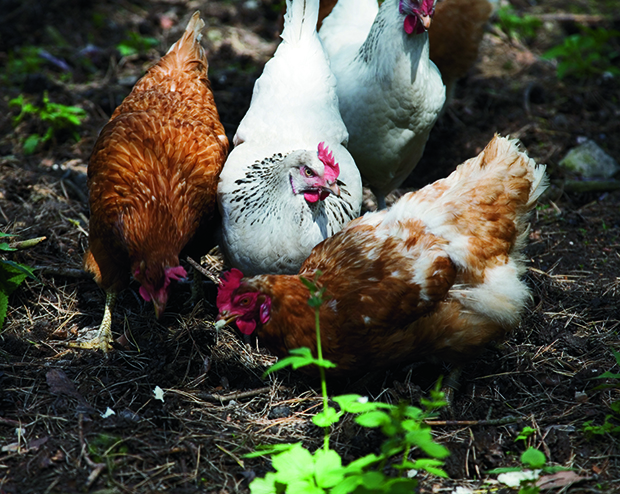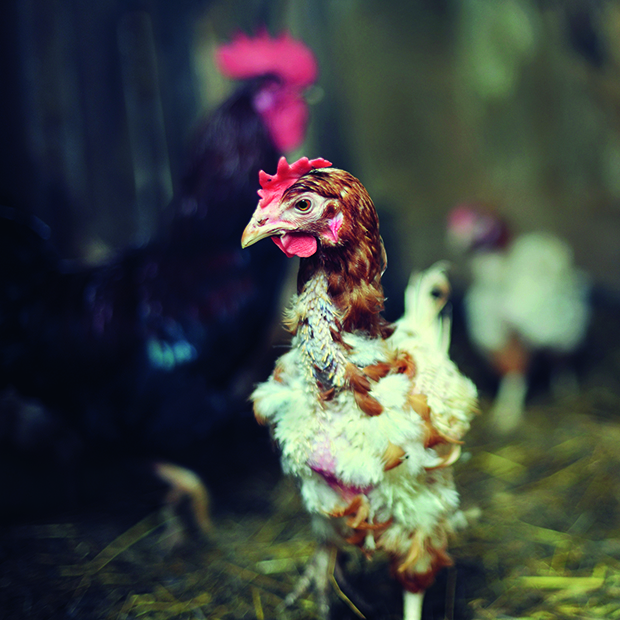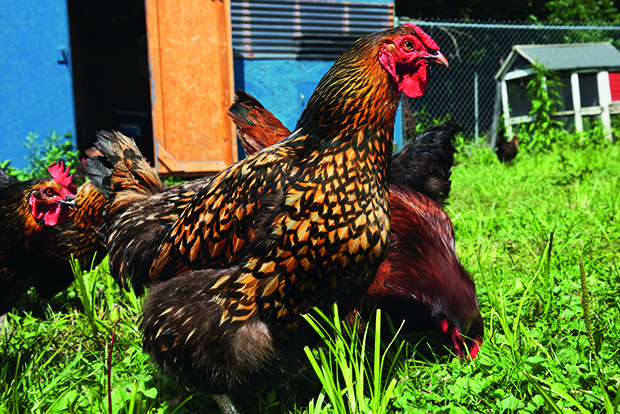How to prevent a backyard feather pecker

Feather pecking can be a problematic and mysterious behaviour, but there are ways to avoid it.
Words: Andrea Graves
I once had a terrible case of feather pecking in my backyard. The hens in question didn’t start out that way, but life went downhill for them very quickly once it started. I live in town, and my three chickens only have a small run. But, being aware of their obsession to forage through loose substrate for hours every day, I frequently top up the coop with leaves, weeds and scrap vegetables. However, I once went away for a few weeks during a wet winter, and I’m afraid my chicken caretaker (my husband) was unreliable. When I returned, their run was floored with nothing but compacted soil and bare mud.
I promptly stocked the run with autumn leaves I’d collected and stashed, but it was too late – the feather pecking had begun. Before long my shyest hen developed a receding hairline, or featherline if you will. Patient observation revealed that another hen was carefully plucking her in a way that reminded me of someone peeling off a friend’s sunburnt skin.
Soon the hen’s chest feathers began to disappear. Then most of her tail feathers went. After a few weeks, the miserable wretch finally began to move away from the plucking, as if she’d only just realised it was happening. For a while this worked and her feathers regrew as purple spikes. They barely had time to unfurl, though, before they were plucked out. This time two of them were at her – and at each other. It was contagious. When I saw my raggedy hen sitting down repeatedly in response to the pecking, I realised it had gone too far. She was sitting to shield her almost-bare rear end from the pecks. It was a lost cause. I had to euthanise her that day, and the other two were replaced shortly afterwards.
Nobody has figured out how to eradicate feather pecking (which is sometimes called feather picking) once it’s entrenched. As with humans, animals’ habits tend to turn into behavioural ruts that persist even when the circumstances that created them change. We are aware that we sabotage ourselves when we go to bed too late or drink every night, but often even this isn’t enough to hoist us out of habits. What chance does a live-in-the-moment animal have of changing its ways?
While feather pecking might seem harmless in many cases, it can escalate very quickly, resulting in distressed birds with bleeding injuries and debilitating pain. It’s therefore important to prevent feather pecking from starting in the first place. The best way to do this is to understand chickens’ instinctive behaviours. By knowing your chickens, you can provide the environment, diet and social lives that will keep them happy and healthy.
WELCOME TO THE JUNGLE
One of the factors that contributes to feather pecking is genetics. Super-layers such as brown shavers and Hy-Lines tend to be more prone to it, and within those breeds, the best layers are often the worst feather peckers. But the environment is an enormous trigger, and you have some control over that.
The best way to manage chicken enclosures is to picture the edge of a jungle – where the ancestors of modern chickens evolved – and try to replicate it. Such an environment provides abundant, diverse material to search through and kick around. That could be straw, leaves, fine tree mulch, piles of weeds or compost; generally any living or dead plant detritus. In fact, a bit of decay is desirable because it means increasing numbers of invertebrates, and chickens find them delicious. Try to avoid including any sharp sticks as these can nick their feet and leave wounds that can become infected.
You’ll notice this scene isn’t the same as a tidy green paddock, which is a human-generated ideal. Avoid anything too manicured. Chickens do enjoy lawns for the greenery – they love green leafy vegetables including grass – and also for the insects and worms that live there. But they’ll usually favour the shrubbery at the edge for its accumulated leaf litter and shelter. This is one reason I’m sceptical of the concept of “pasture-raised eggs’’ I’d prefer jungle eggs any day.

LOOK DOWN
When planning for happy chickens, it pays to look down. You’ve probably noticed that a well-occupied chook is often doing just that in a characteristic head-down, tail-up exploring manner. For these animals, barren ground is an abomination. They have a deep urge to explore messy surfaces; to sort and scrape and root at it, hoping to uncover goodies – even if their bellies are already full – often for many hours every day. This might seem like a waste of energy, but it’s their instinct, and we ignore this need at our peril and theirs.
The consequence of bare ground is bored animals. While this may seem innocuous, boredom can lead to frustration, which can lead to abnormal behaviours that can become extremely problematic. In chickens, one of these behaviours is feather pecking. It works like this: if the ground is unbearably boring, a hen’s flockmate’s feathers are a half-decent substitute.
CHICKEN-FRIENDLY RESOURCES
The smaller your chickens’ enclosure, the more effort you’ll need to put into keeping its ground looking more like a jungle and less like bare, compacted dirt or mud. If you don’t have much material to throw in there, a good dig with a spade or fork to loosen soil can provide some temporary relief.
Bear your chickens’ needs in mind during tasks such as weeding, raking or edging and consider whether they yield any chicken-friendly resources. Weeds are a treasure trove of green vegetation, soil and tiny creatures, so toss them to your incessantly searching birds. Every dug-out dandelion or gone-to-seed vegetable is a valuable resource.
Consider starting a compost heap, which is thrilling for chickens to search through. Could you give them access to one? They will inevitably spread out the ingredients too far for decent composting to occur unless you contain the heap with walls or banks. Note that if a heap is open-access to chickens it will be open-access to rodents, too, so you’ll also need to be a smart trapper or baiter.
And have you seen all the delicious creatures that gather under a rotting log? Branches placed around the run provide decent perches, and if you roll them over now and then you’ll reveal tantalising pickings for your birds underneath.

SOCIAL LIVES
While chicken society is renowned for its pecking order, the hierarchy can be barely noticeable within a stable group. But it all goes to hell when groups are mixed or new individuals introduced, and physical attacks are not uncommon. Through fighting, chickens establish a new hierarchy within weeks, after which the order is maintained peaceably through subtle posturing and avoidance behaviours. However, attacks that occur due to a disrupted pecking order are very different from feather pecking.
They are hard, aggressive pecks directed to the head region, and the victim’s sounds and movements are clearly fearful.
Feather pecking is quite different; it’s more neurotic than nasty and often includes areas other than the head. To complicate things, there is also a distinction between gentle feather pecking, which is more akin to grooming and causes no obvious harm to plumage, and severe feather pecking, which progressively denudes the feathers.
The intrinsic sociability of chickens is part of the problem. They watch each other and learn rapidly from others’ behaviour, particularly that of dominant chickens – who I like to call social influencers – which is why feather pecking can be contagious.
FEED TYPE
A final tip that home chicken-keepers can act on is the choice of feed. In nature, chickens have evolved to use their senses, beaks and feet intensively to find food on the forest floor. A tidy heap of pelletised food is, in contrast, rapidly and easily gobbled, requiring less of their attention. To solve this problem, choose a dry mash feed from a certified supplier. Mash is generally the same stuff as pellets except it hasn’t been formed into shapes, allowing chickens to sift through material and keep themselves amused.

BEAK TRIMMING
Keeping a relatively small number of birds at home allows poultry owners to cater to their needs, create the best environment and ensure they enjoy happy, balanced lives. It’s immeasurably harder when there are thousands of chickens squeezed into the constraints of a farming system. Feather pecking is very common in commercial flocks – even free-range ones. This is why chicks or pullets bought from commercial breeders or rearers have often had their beaks trimmed or smoothed off at the tip. The intent is to protect birds from later harm, because it’s much easier to cause damage with a sharp beak. However, beak trimming causes pain and sensory deprivation, and the practice has provoked heated debate in the poultry and egg sector about which is worse for chicken welfare – beak trimming or allowing feather pecking to occur. Many countries have banned beak trimming and opted to encourage changes in lighting in hen houses and farms, which have been reported to reduce chicken stress and reduce feather pecking.
Love this story? Subscribe now!
 This article first appeared in NZ Lifestyle Block Magazine.
This article first appeared in NZ Lifestyle Block Magazine.
